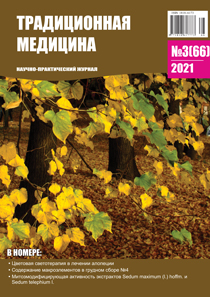СОДЕРЖАНИЕ МАКРОЭЛЕМЕНТОВ В ГРУДНОМ СБОРЕ №4
DOI:
https://doi.org/10.54296/18186173_2021_3_19Ключевые слова:
лекарственное растительное сырьё, сборы, макроэлементы, атомно-эмиссионная спектрометрияАннотация
Грудной сбор №4 широко применяется для лечения и профилактики заболеваний дыхательных путей, включая новую коронавирусную инфекцию. Лекарственное растительное сырьё, входящее в состав сбора, является источником не только биологически активных веществ, но и минеральных элементов. Цель работы – изучить содержание макроэлементов, которые могут потенциировать действие биологически активных веществ компонентов грудного сбора №4.
Методом атомно-эмиссионной спектрометрии определено содержание калия (K), натрия (Na), магния (Mg), кальция (Ca), фосфора (P), серы (S) и железа (Fe) в грудном сборе №4 и его компонентах: ромашки аптечной цветках, багульника болотного побегах, календулы лекарственной цветках, фиалки траве, солодки корнях, мяты перечной листьях. Было установлено, что содержание макроэлементов находится в диапазоне 62,71–21705,63 мг/кг. Их средние значения убывали в ряду: K > Ca > Mg > P > S > Na > Fe.
В отдельных компонентах сбора найдены наибольшие количества элементов (в 1,5–7 раз больше, чем в других видах): в мяты перечной листьях – Ca и S, в календулы лекарственной цветках – Na и Fe, в фиалки траве – K, в ромашки аптечной цветках – Mg, в солодки корнях – P. По сравнению с грудным сбором №4 в его сухом экстракте концентрация изученных элементов в 2–4 раза выше. Обнаружено, что содержание калия, натрия, магния, кальция, фосфора, серы и железа в грудном сборе №4 составило 30–70 % от адекватного уровня потребления, что позволяет рассматривать этот сбор как дополнительный источник поступления этих макроэлементов в организм человека.
Библиографические ссылки
Фитопрепараты, анализ фармацевтического рынка Российской Федерации / Н.Н. Бойко, А.В. Бондарев, Е.Т. Жилякова [и др.] // Научный результат. Медицина и фармация. – 2017. – Т.3, №4. – С. 68–75.
Сравнительный анализ номенклатуры лекарственного растительного сырья, используемого в отечественной и мировой фармакопейной практике / Л.Н. Фролова, Е.Л. Ковалева, Е.И. Саканян [и др.] // Ведомости Научного центра экспертизы средств медицинского применения. – 2020. – №1. – C.29–40.
Мельникова, И.М. Комбинированные отхаркивающие препараты растительного происхождения в педиатрической практике / И.М. Мельникова, Ю.Л. Мизерницкий // Медицинский совет. – 2018. – №2. – C.93–97.
Государственная фармакопея Российской Федерации 14 издание / Москва, 2018 [Электронный ресурс]. Режим доступа: http://femb.ru/femb/pharmacopea.php. (Дата обращения: 10.08.2021)
Государственная фармакопея Республики Беларусь 2 издание // Минск – 2013. – Том 1. – С.448.
European Pharmacopoeia 10th Edition//Strasbourg – 2021. – Р. 4392.
British Pharmacopoeia //Bournemount – 2014. – P.1024.
Филиппова, И. Рынок растительных средств: проблемы, перспективы, приоритеты / B/ Филиппова // Ремедиум. – 2016. – №7–8. – С. 15–16.
Петров, Е.В. Теоретические предпосылки разработки рецептур многокомпонентных фитопрепаратов на основе опыта традиционной медицины / Е.В. Петров, Т.А. Асеева, Г.В. Чехирова // Бюллетень ВСНЦ СО РАМН. – 2009. – №3. – С.222–224.
Битюцкий, Н.П. Минеральное питание растений / Н.П. Битюцкий. – СПб.: СПБГУ, 2017. – C.10–60.
Орбелис, Д. Биологическая роль макро- и микроэлементов у человека и животных / Д. Орбелис, Б. Хараланд, А. Скальный. – СПб.: Наука, 2008. – 544 с.
Скальная, М.Г. Макро- и микроэлементы в питании современного человека / М.Г. Скальная, С.В. Нетова // Журнал Российского общества медицинских элементологов. – 2004. – Т.3, №1. – С.135–146.
Микроэлементозы человека: этиология, классификация, органопатология / А.П. Авцын, А.А. Жаворонков, М.А. Риш, Л.С. Строчкова. – М.: Медицина, 1991. – 496 с.
Морозова, Л.В. Химические элементы в организме человека. Справочные материалы / Л.В. Морозова. – Архангельск: Издательский центр ПГУ, 2001. – 43 с.
Oral magnesium supplementation in asthmatic children: a double-blind randomized placebo-controlled trial / C. Gontijo-Amaral, M.A.G.O. Ribeiro, L.S.C. Gontijo [et al.] // Eur. J. Clin. Nutr. – 2007. – №1. – P.54–60.
Effect of oral magnesium supplementation on measures of airway resistance and subjective assessment of asthma control and quality of life in men and women with mild to moderate asthma: a randomized placebo controlled trial / A.G. Kazaks, J.Y. Uriu-Adams, T.E. Albertson [et al.] // J. Asthma. – 2010. – №1. – P.83–92.
Possibility of magnesium supplementation for supportive treatment in patients with COVID-19 / C. Tang, H. Ding, R. Jiao [et al.] // Eur. J. Pharmacol. – 2020. – №1. – P.64–69.
Фармакогнозия. Экотоксиканты в лекарственном растительном сырье и фитопрепаратах: учебное пособие / И.В. Гравель, Я.Н. Шойхет, Г.П. Яковлев, И.А. Самылина. – М.: ГЭОТАР-медиа, 2012. – 304 с.
МУК 4.1.1482–03. Определение химических элементов в биологических средах и препаратах методами атомно-эмиссионной спектроскопии с индуктивно-связанной плазмой и масс-спектрометрии с индуктивно-связанной плазмой: метод. указания. – М.: Федеральный центр госсанэпиднадзора Минздрава России, 2003. – 56 с.
Почему растения лечат / М.Я. Ловкова, А.М. Рабинович, С.М. Пономарева [и др.]. – М.: Наука, 1990. – 290 с.
The determination of elements in herbal teas and medicinal plant formulations and their tisanes / P. Pohl, A. Dzimitrowicz, D. Jedryczko [et al.] // J. Pharm. Biomed. Anal. – 2016. – №2. – P.97–104.
МР 2.3.1.1915-04 Рекомендуемые уровни потребления пищевых и биологически активных веществ. – М.: НИИ питания РАМН, 2004. – 36 с.
Загрузки
Опубликован
Как цитировать
Выпуск
Раздел
Лицензия
Условия использования и передачи авторских прав указаны в Договоре (публичной оферте), который размещен на нашем сайте.
Перепечатка материалов без письменного разрешения редакции журнала запрещена.
Ответственность за достоверность сведений, содержащихся в статьях и рекламных объявлениях, несут авторы и рекламодатели.






